If you collect vintage leather football artifacts, a general knowledge of preservation techniques is essential for the protection of your investment. Following a basic preservation plan can stabilize the structure and moisture content of leather artifacts and arrest or slow the rate of deterioration. Once leather becomes brittle and begins to crack, its condition cannot be reversed. A proactive preservation strategy is the only way to maintain the condition and value of your collection.
Humidity
Preservation of Leather Artifacts
Temperature
Light
Support & Display
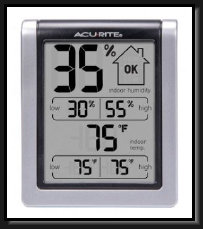
The single most important variable in the preservation of leather artifacts is maintaining proper relative humidity (RH) where you store or display your collection. At high humidity levels (>70% RH), leather absorbs moisture, which can lead to biological infestation and microbic deterioration such as mold and bacteria growth. At low humidity levels (<25% RH) leather begins to dehydrate permanently, leading to shrinkage and deformation. Once dehydrated, the leather begins to weaken, lose flexibility, crack and check.
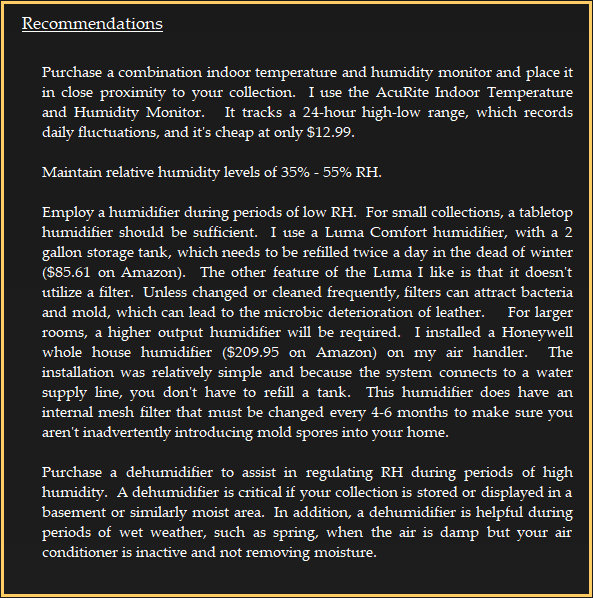
Humidity is typically highest in ambient air during summer months and rain events. Basements are notoriously humid as well as water in the surrounding soil leeches through the walls. When in operation, modern air conditioning systems are relatively efficient at keeping humidity levels below 60% RH as one of the primary functions of air conditioning is the removal of moisture from the air. Cold air, on the other hand, cannot hold as much moisture as warm air, and RH levels in winter months can be dangerously low. In addition, fireplaces, central heat, space heaters, and radiators can suck what little moisture remains from the air, making winter a prime time for leather deterioration.
Excessive heat can dry out leather and reduce its tensile strength which leads to cracking and splitting. Unfortunately, when combined with high humidity, high heat a) accelerates chemical deterioration of leather, b) can lead to oxidative degradation, and c) can cause the oils and fats within the leather to seep to the surface where they crystallize and form white deposits.
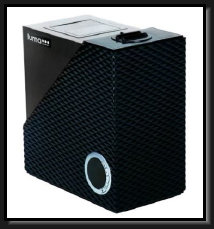

Luma Comfort Humidifier
Honeywell Whole-House Humidifier
AcuRite Temperature & Humidity Monitor
1.
2.
3.
4.
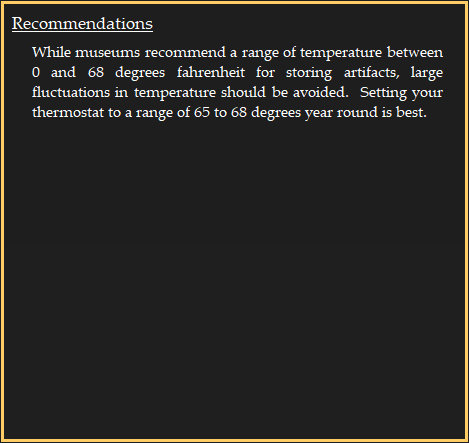
1.
3.
Avoid storing leather artifacts in unconditioned spaces, such as attics, outbuildings, unfinished basements, and storage units. Enclosed display cases are best for the management of temperature, humidity air flow, and contaminants.
4.
Keep your collection out of rooms that get direct afternoon sunlight, or near HVAC vents, space heaters, radiators, and incandescent lighting sources.
2.
Keep a temperature monitor near your collection. Your HVAC thermostat reading is only accurate in the immediate vicinity of the thermostat. Temperatures can vary significantly between your thermostat and your collection. The AcuRite monitor mentioned above includes a 24 hour temperature range reading that will help you identify any temperature spikes that may occur throughout the day/night.
Cracking and splitting of leather caused by high temperatures and low humidity
For thousands of years humans have tanned animal skins to transform a biodegradable substance into a durable, weather resistant, and flexible material that is resistant to rot and decay. Nearly all vintage football equipment leather is a vegetable or mineral tanned cow hide or calf skin. The type of tanning process used can play a significant role in the longevity of an antique leather artifact. In some cases, the chemicals used in the tanning process to protect the leather can ultimately contribute to the deterioration process when combined with certain environmental conditions and contaminants. The most important environmental conditions that the collector can manage to extend the life of leather artifacts are humidity, temperature, light, airborne contaminants, and structural support.
Leather
Both ultraviolet (UV) and visible light can cause irreversible color and structural changes in leather. Prolonged exposure to both forms can result in photodegradation, the fading of the pigments and dyes within leather. Over time this can bleach out the color of an artifact and cause differential fading on the surfaces of objects that are unequally lit. Not only does sunlight generate heat that can dry out leather, it is our primary natural source of UV radiation. UV radiation oxidizes collagen and breaks down the structural bonds of leather. Display lighting can be equally damaging to leather artifacts. Incandescent light bulbs generate significant heat but practically no UV radiation. Compact fluorescent bulbs generate less heat but emit higher levels of UV radiation. LED lights are more energy efficient than incandescent and compact fluorescent bulbs and generate practically no heat or UV radiation.

1.
Minimize periods of illumination. Turn off lighting when you aren't displaying your collection.
3.
2.
Museums recommend that exhibits be illuminated to the minimum level required to adequately display an artifact. I recommend the use of LED lighting, which has a low heat and UV signature. I prefer dimmable LED light bulbs with a warm color temperature of 2700k - 3000K. Combine the bulbs with a dimmer switch for greater control of your lighting levels.
Display with dimmable LED spotlights
Photo showing museum display lighting levels National Marine Corps Museum
Airborne Contaminants
Dust, smoke, and grease are the main airborne pollutants found within most homes. Dust may seem like an innocuous nuisance, but when combined with moisture and other pollutants it can adhere to and degrade leather artifacts. Sulfur dioxide can become airborne when fossil fuels are burned (fireplaces, oil heaters, etc.). When combined with moisture and oxygen, airborne sulfuric acid is formed which can lead to a chemical deterioration of leather called "red rot." Red rot attacks leather fibers and breaks it down into a dry, reddish powder. This condition cannot be reversed.
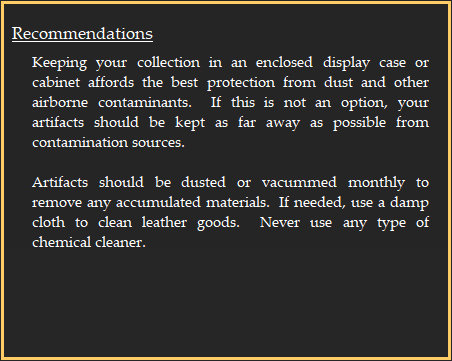
1.
2.
Make sure you use quality air filters in your HVAC system and replace them every 3 months. Today's filters are capable of capturing smoke and airborne chemicals that attached dust.
Cigarette and fireplace smoke contains many harmful chemicals, including carbon monoxide, formaldehyde, sulfur dioxide, toluene, benzene, methane, and VOCs, which can be circulated by HVAC systems. Similarly, cooking or frying oils can become airborne and settle on artifacts. Many of these contaminants are readily absorbed into leather, causing discoloration, oxidation and deterioration.
3.
Proper preservation practices can greatly extend the life and maintain the appearance of antique leather. Ultimately however, all leathers will stiffen and lose flexibility. Proper support is critical to preserving the artifact's shape and minimizing stress on the leather fibers. Once an artifact has reached a moderate degree of dryness, altering its static shape is nearly impossible. Leather that has started to embrittle should not be forced onto a form that it won't comfortably rest upon.
For vintage football head harnesses there are a variety of display alternatives available. Antique millinery hat forms and yarn spools make a attractive vintage display. Keep in mind however, that these objects may have been treated with or exposed to chemicals in their prior lives and that those chemicals can leech onto artifacts over time. Inspect any vintage stand or form carefully before use. Museum curators recommend that any wood that comes into contact with an artifact be first treated with a water-based polyurethane and then allowed to dry for several days.
Styrofoam head forms are inexpensive alternative for displaying head harnesses. Styrofoam is made from polystyrene, which is a petroleum based product containing benzene, ethylene, and hydrofluorocarbons. There is scientific evidence that styrofoam leeches into fluids and organic matter when heated. Whether or not leeching can occur at room temperature is unknown.
For vintage football head harnesses there are a variety of display alternatives available. Antique millinery hat forms and yarn spools make a attractive vintage display. Keep in mind however, that these objects may have been treated with or exposed to chemicals in their prior lives and that those chemicals can leech onto artifacts over time. Inspect any vintage stand or form carefully before use. Museum curators recommend that any wood that comes into contact with an artifact be first treated with a water-based polyurethane and then allowed to dry for several days.
Styrofoam head forms are inexpensive alternative for displaying head harnesses. Styrofoam is made from polystyrene, which is a petroleum based product containing benzene, ethylene, and hydrofluorocarbons. There is scientific evidence that styrofoam leeches into fluids and organic matter when heated. Whether or not leeching can occur at room temperature is unknown.
Red rot on the ear flap of a leather helmet
millinery hat form
glass mannequin head
wooden yarn spool
styrofoam head
Raincap that had been stored flat for years

Examples of Head Harness Display Forms







